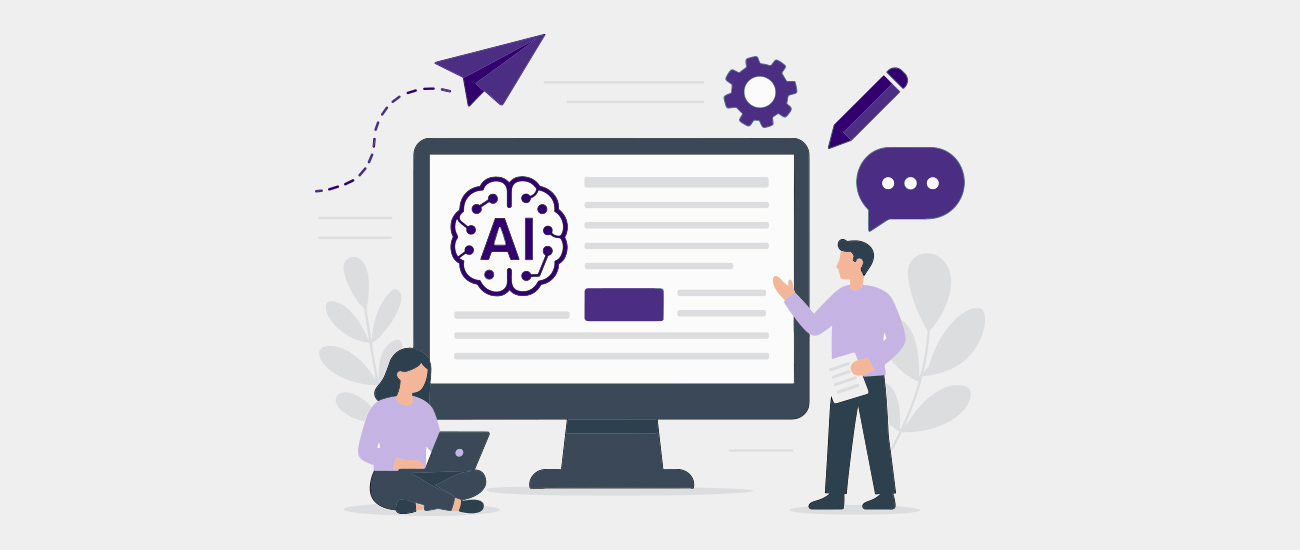Generative artificial intelligence (AI) offers powerful tools that can support content creation — helping us develop and edit copy, brainstorm ideas, write captions, tighten up social posts and more. But because generative AI is trained on existing data, we must use it carefully to avoid plagiarism, misinformation and bland or off-brand messaging.
The College's Marketing and Communications team has developed the following guidelines for responsible AI use when developing and managing written and visual content.

What can I use AI for?
AI can support many stages of the content development, posting and publishing process. Examples include:
- Generate social posts and story ideas, angles and outlines
- Brainstorm interview questions
- Suggest titles, subheads, alt text or short-form copy
- Design quiz or survey questions
- Suggest ideas for image subject matter and photo shoots
- Reword or shorten content for clarity, tone or specific audiences or placement
- Summarize documents, meeting notes or interviews
- Organize background material or data from multiple sources
- Paraphrase technical content or explain complex concepts
- Transcribe notes from an interview
- Assist with task planning (for example, setting production schedules or managing content calendars)
- Check grammar, spelling, punctuation and readability
- Adjust tone and style for consistency
- Identify unclear phrasing or problematic terminology
- Suggest alternative word choices
- Review from different users’ perspectives
- Assist with simple image tasks like resizing photos or expanding generic backgrounds
No matter the task, remember: AI output should always be reviewed and verified by a human before sharing externally.
Did AI write it?
Tools like Grammarly, ZeroGPT, Scribbr and Quillbot can help assess whether text was likely generated by AI.
What shouldn't I use AI for?
AI can assist us in our work, but it also has limitations:
- It can hallucinate – AI may generate content that sounds plausible but isn’t accurate.
- It can be boring – AI often produces generic, flat copy.
- It lacks depth – While useful for straightforward tasks, AI struggles with nuance, complexity and high-stakes writing.
- It can manipulate and create false quotations – Even if you tell it not to, AI may still adjust quoted material in your draft copy. It may also create new quoted material and attribute it to your subject.
- It can be biased – AI may reflect or amplify harmful biases present in its training data.
- It may compromise privacy – Don’t upload sensitive or confidential information into AI tools.
So, avoid using AI for tasks that require human judgment, originality or involve sensitive information.
Specifically, do not use AI to:
- Create entire pieces of original text, video, audio or images
- Generate and add new elements into an image (note: generic background fills are fine)
- Analyze or process private, sensitive or confidential content
- Fact-check information
- Create or edit content without the subject’s or author’s consent
- Replace human input where nuance, empathy or creativity are essential
Caution: Sensitive or private information
It is critical that we do not input any sensitive or private information into AI tools. This includes personal details (such as contact information, student or donor records), confidential or embargoed content, or proprietary data. Once entered into an AI system, this information may be stored, used to further train the model, or become accessible in ways we cannot control—creating risks for privacy, security and compliance.
Is it ok to use AI-generated images?
The College’s Marketing & Communications team avoids using AI-generated images — especially in high-visibility areas like the website homepage, publication covers and similar contexts.
- AI-generated images are often hyper-realistic but may contain subtle flaws. Look for unnatural features like distorted hands, asymmetrical faces, inconsistent lighting or overly smooth textures.
- Backgrounds and text may appear warped or nonsensical.
- You can also check metadata. Many AI images lack standard camera details.
- For extra help, tools like AI or Not, Hive Moderation or reverse image searches can help verify whether an image is AI-generated.
It’s fine to use stock imagery when needed, but be cautious with AI-generated stock images. Some stock services clearly label AI-generated content, while others do not.
Automated AI
Be aware that many tools we use in our everyday work, such as Canva and Microsoft Word, have AI baked in. Be mindful of automated AI suggestions, and remember that you are responsible for reviewing, verifying and aligning any AI-generated content with our brand and editorial standards.
How do I ensure I’m using AI properly?
All AI-generated work should be carefully reviewed by a human before it is disseminated. If you have questions about these guidelines, or whether something can or should be done with AI, contact us.
Additional resources
- Generative Artificial Intelligence General Use Guidelines – UW Information Technology
- University Advancement AI Guidelines – UW NetID required
- UW Engineering accessibility guidelines
- UW Engineering brand and style guidelines
Last updated November 2025